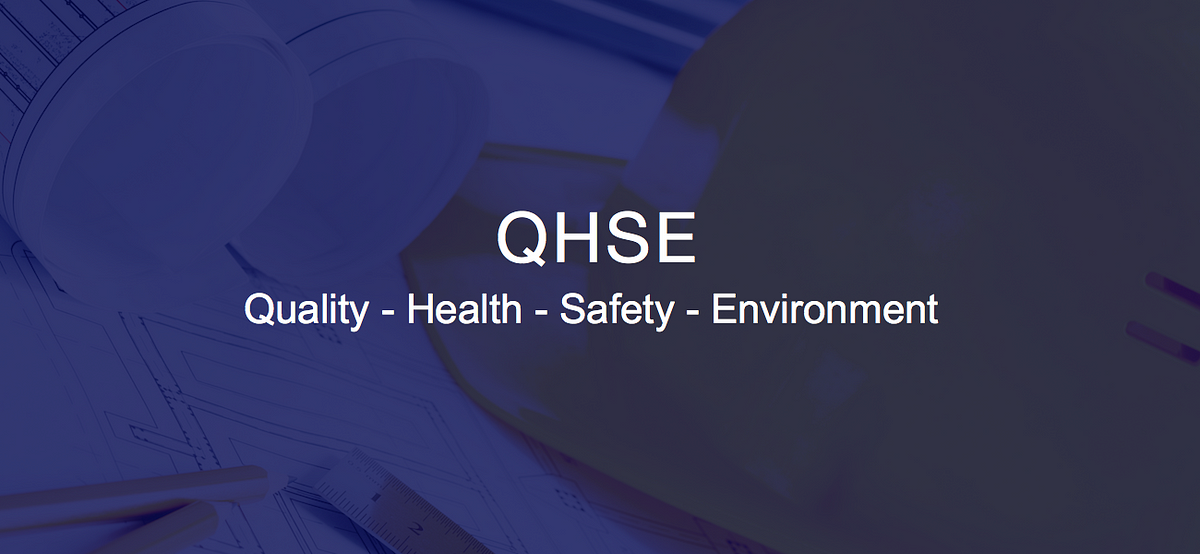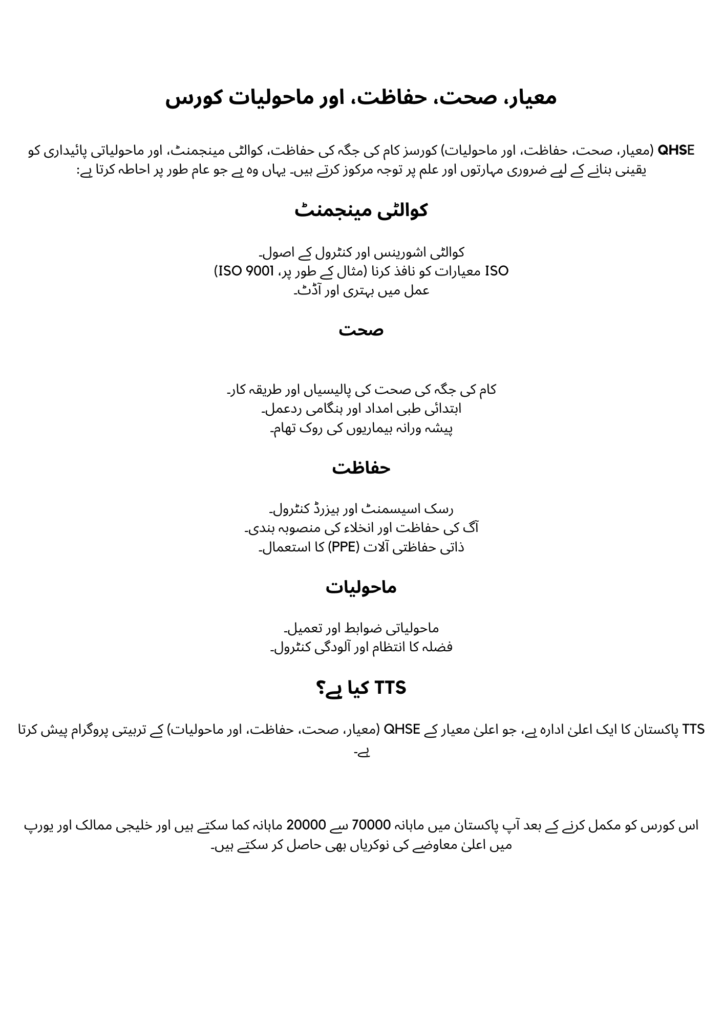
Advanced QHSE Training Certification Course in Pakistan: Excellence in Quality, Health, Safety, and Environmental Management
Course Objectives
• Equip participants with a robust understanding of QHSE principles and their applications in modern industries.
• Build competence in developing, implementing, and auditing QHSE management systems.
• Foster a culture of safety, quality assurance, and environmental sustainability in organizations.
• Prepare participants for QHSE certifications and compliance with international standards.
Target Audience
• HSE Managers, Quality Assurance Professionals, and Environmental Officers.
• Engineers, Supervisors, and Project Managers.
• Students and professionals aiming to enter the QHSE domain.
Course Duration
• 10 Weeks (40 Hours of instruction + 20 Hours of practice and assessments)
Outline
1. Introduction to QHSE (Duration: 1 Week)
• Understanding the Importance of QHSE in Modern Industries.
• Key International Standards: ISO 9001, ISO 45001, ISO 14001.
• Role of QHSE in Risk Mitigation and Operational Excellence.
• Case Study: Real-life examples of QHSE failures and their consequences.
2. Quality Management Systems (QMS) (Duration: 2 Weeks)
• Principles of Quality Management.
• Overview of ISO 9001 Standards.
• Developing and Maintaining Quality Control Processes.
• Practical Activity: Designing a simple quality checklist for a manufacturing process.
3. Health and Safety Management Systems (HSE) (Duration: 2 Weeks)
• Fundamentals of Workplace Safety: Hazard Identification and Risk Assessment (HIRA).
• Overview of ISO 45001 Standards.
• Emergency Preparedness and Response Planning.
• Lab Activity: Conducting a mock safety inspection and creating a risk mitigation plan.
4. Environmental Management Systems (EMS) (Duration: 1 Week)
• Overview of Environmental Management and Sustainability Principles.
• Understanding ISO 14001 Standards and Compliance.
• Waste Management, Pollution Control, and Resource Efficiency.
• Case Study: Implementing an environmental management plan in a construction project.
5. Integrated QHSE Management Systems (Duration: 1 Week)
• Benefits of Integrating QMS, HSE, and EMS.
• Frameworks for Developing Integrated Systems.
• Challenges and Best Practices for Implementation.
• Practical Activity: Develop a high-level integrated QHSE policy document.
6. Auditing and Compliance (Duration: 1 Week)
• Basics of Internal and External QHSE Audits.
• Preparing for Certification Audits (ISO 9001, ISO 45001, ISO 14001).
• Common Non-Conformities and How to Address Them.
• Practical Session: Role-play a QHSE audit with participants as auditors and auditees.
7. Advanced Safety Techniques (Duration: 1 Week)
• Behavioral-Based Safety (BBS).
• Incident Investigation and Root Cause Analysis.
• Personal Protective Equipment (PPE) and Safety Technology.
• Lab Session: Conducting a mock incident investigation using root cause analysis tools.
8. Leadership and Culture in QHSE (Duration: 1 Week)
• Building a Culture of Quality, Safety, and Environmental Responsibility.
• Leadership’s Role in Promoting QHSE Initiatives.
• Effective Communication Strategies in QHSE Management.
• Guest Lecture: Insights from a QHSE leader in a multinational organization.
9. Emerging Trends in QHSE (Duration: 1 Week)
• The Role of Digital Tools and AI in QHSE Management.
• Sustainability and Corporate Social Responsibility (CSR).
• Global Trends: Circular Economy, Carbon Footprint Reduction, and ESG Integration.
• Discussion Session: How modern technologies are shaping the future of QHSE.
10. Capstone Project (Duration: 2 Weeks)
• Project Scope: Develop a comprehensive QHSE plan for a hypothetical organization.
• Identify key risks, propose mitigation strategies, and include integrated management elements.
• Present the project to peers and instructors for feedback and improvement.
Assessment & Certification
• Weekly Quizzes and Assignments: Testing theoretical knowledge and practical skills.
• Capstone Project Evaluation: Innovation, feasibility, and alignment with QHSE standards.
• Certification: Participants receive a “Certified QHSE Specialist” certificate upon completion.
Course Duration - Charges
NEBOSH IGC-UK
PKR: 130000 (01-Month)
IOSH MS-UK
PKR: 25000 (02-Weeks)
Safety Inspector
PKR: 35000 (03-Months)
QA -QC
PKR: 10000 (02-Weeks)

NEBOSH IGC
| Course Title | NEBOSH IGC |
| Entry Level | Bachelors degree or good level of English |
| Duration of Course | 4 – Weeks |
| Training Methodology | Theory & Practical |
| Medium of Instruction | Urdu / English |
Course Content
| Why manage workplace Health & Safety | Health & safety Management system |
| Managing Risk- Understanding people processes | Health & safety Monitoring & Measurement |
| Health & safety Audit | Physical and Psychological Health |
| Musculoskeletal Health | Chemical & Biological Agents |
| General Workplace Issues | Work Equipment Safety |
| Fire Safety | Electrical Safety |
IOSH MS
| Course Title | IOSH – MS |
| Entry Level | Intermediate |
| Duration of Course | 10 – Days |
| Training Methodology | Theory & Practical Risk Assessment Report |
| Medium of Instruction | Urdu / English |
Course Content
| Introduction to Managing Safely | Assessing Risks | ||
| Controlling Risks | Understanding Responsibilities | ||
| Understanding Hazards | Investigating Incidents | ||
| Measuring Performance |
Safety Inspector
| Course Title | Safety Inspector |
| Entry Level | Matric |
| Duration of Course | 3 – Months |
| Training Methodology | Theory & Practical |
| Medium of Instruction | Urdu / English |
Course Content
| Introduction to HSE | Safety Orientation & ERP |
| Objectives of HSE | Justification for HSE |
| Hazards | PPEs |
| JD of safety inspector | HSE Policy |
| Duty of Care | International Standards & OSHA |
| HSE Management System | SSOW/JSA/SREDIM |
| Risk | Incident & Disasters |
| Incident Investigation | Safety Culture |
| Safety Communication | Safety Talks |
| Safety Signs | Color Coding |
| LOTO | PTW |
| Safety meetings | Auditing |
| Monitoring | Injury |
| First-Aid | Radiations & Radiography |
| Substance Misuse | Slips, Trips and Falls |
| Haz-Mat | Material Safety Data Sheet |
| Material Handling Techniques | Ergonomics |
| Behavioral Safety | Fire |
| Work at Height | Ladders |
| Scaffolding | Excavation |
| Concrete & Masonry | Confined space & SBM |
| H2S safety | Demolition Safety |
| Electrical Safety | Arc Flash & Arc Blast Safety |
| Plant shutdown | Crane safety |
| Rigging | Machine Safety |
| Tools | Traffic Safety |
| Pollution | Waste Management |
| Noise | Vibration |
| Sand Blasting | Stress at Work |
| Violence at Work | Food safety |
| Pressure testing | Compressed gas safety |
| Welding | Housekeeping |
| Welfare Facilities | Employee safety handbook |
Fire Safety
| Course Title | Fire Safety |
| Entry Level | Matric |
| Duration of Course | 10 – Days |
| Training Methodology | Theory & Practical |
| Medium of Instruction | Urdu / English |
Course Content
| Introduction to Fire Safety | Fire Triangle | ||
| Fire Classes | PPE for Fire Fighting | ||
| Phases of Fire | Fire Behavior | ||
| Identifying & Controlling Heat Sources | Identifying & Controlling Fuel Sources | ||
| Identifying & Controlling Oxygen Sources | Housekeeping | ||
| Fire Detectors | Fire Alarm System | ||
| Fire Blankets | Fire Extinguishers | ||
| Fire Hydrant System | Sprinkler System | ||
| Fire Vehicles | Advanced Fire Fighting | ||
| Fire Fighting Team | Fire Emergency Plan | ||
| Fire Emergency Arrangements | Fire Risk Assessment |
First Aid
| Course Title | First Aid |
| Entry Level | Matric |
| Duration of Course | 10 – Days |
| Training Methodology | Theory & Practical |
| Medium of Instruction | Urdu / English |
Course Content
| Introduction to Rescue & First Aid | General Rules of Rescue & First Aid | ||
| Purposes, Benefits and Limitation of Rescue & First Aid | Terms & Definition related to First Aid | ||
| First Aid Team and their Responsibilities | Basic Equipment for Rescue & First Aid | ||
| Types of Medical Emergency | Types of Injuries (Head, Neck or Spine Injury) | ||
| Sprains and Strains, Abrasions, Lacerations, Puncture Wounds and Amputations | Infant, child and Adult CPR Procedure | ||
| First aid for Internal & External Bleeding | First aid for Burns | ||
| First aid for choking & asphyxia | First aid for Fainting | ||
| First aid for Fracture | First aid for Heart Attack | ||
| First aid treatment for Shock | First aid treatment for Poisoning | ||
| First aid for Heat Stresses |
QA/QC
| Course Title | QA/QC |
| Entry Level | Intermediate |
| Duration of Course | 10 – Days |
| Training Methodology | Theory & Practical |
| Medium of Instruction | Urdu / English |
Course Content
| Introduction to Managing Safely | Fundamentals of Quality | ||
| Quality Assurance | Quality Management System | ||
| Quality Control | Total Quality Management | ||
| Application of Quality |
HABC Delivering Training
| Course Title | Level 3 International Award in Delivering Training |
| Entry Level | Matric |
| Duration of Course | 5 days |
| Training Methodology | Theory & Practical |
| Medium of Instruction | Urdu / English |
Course Content
| Introduction | Preparing for training |
| Practical considerations while planning training | Planning a training session |
| Delivery | Assessment and evaluation |
| Micro teaching session |
HABC Fire Safety
| Fires in the workplace | Fire Safety Standards | ||
| Protecting people and property | Fire Risk Assessments | ||
| The role of the fire warden | The role of the fire warden |
HABC Health and Safety
| Course Title | Level 3 Award in Health and Safety |
| Entry Level | Matric |
| Duration of Course | 5 days |
| Training Methodology | Theory & Practical |
| Medium of Instruction | Urdu / English |
Course Content
| Introduction to health and safety | Accidents |
| Legal Aspects | Management of health and safety |
| Risk Assessment | Hazardous substances |
| The workplace | Using equipment safely |
| Fire Safety | Health at work |
| Ergonomics, manual handling and display screen equipment | The role of line managers and supervisors |
| Consultation |
HABC Work and Height
| Course Title | Level 2 Award in Working at height |
| Entry Level | Matric |
| Duration of Course | 03 – Days |
| Training Methodology | Theory & Practical |
| Medium of Instruction | Urdu / English |
Course Content
| Introduction | Law and responsibilities | ||
| What is work at height? | Hazards of work at height | ||
| Control measures hierarchy | Risk Assessment and rescue plan | ||
| Work at height equipment | Personal fall protection equipment |

